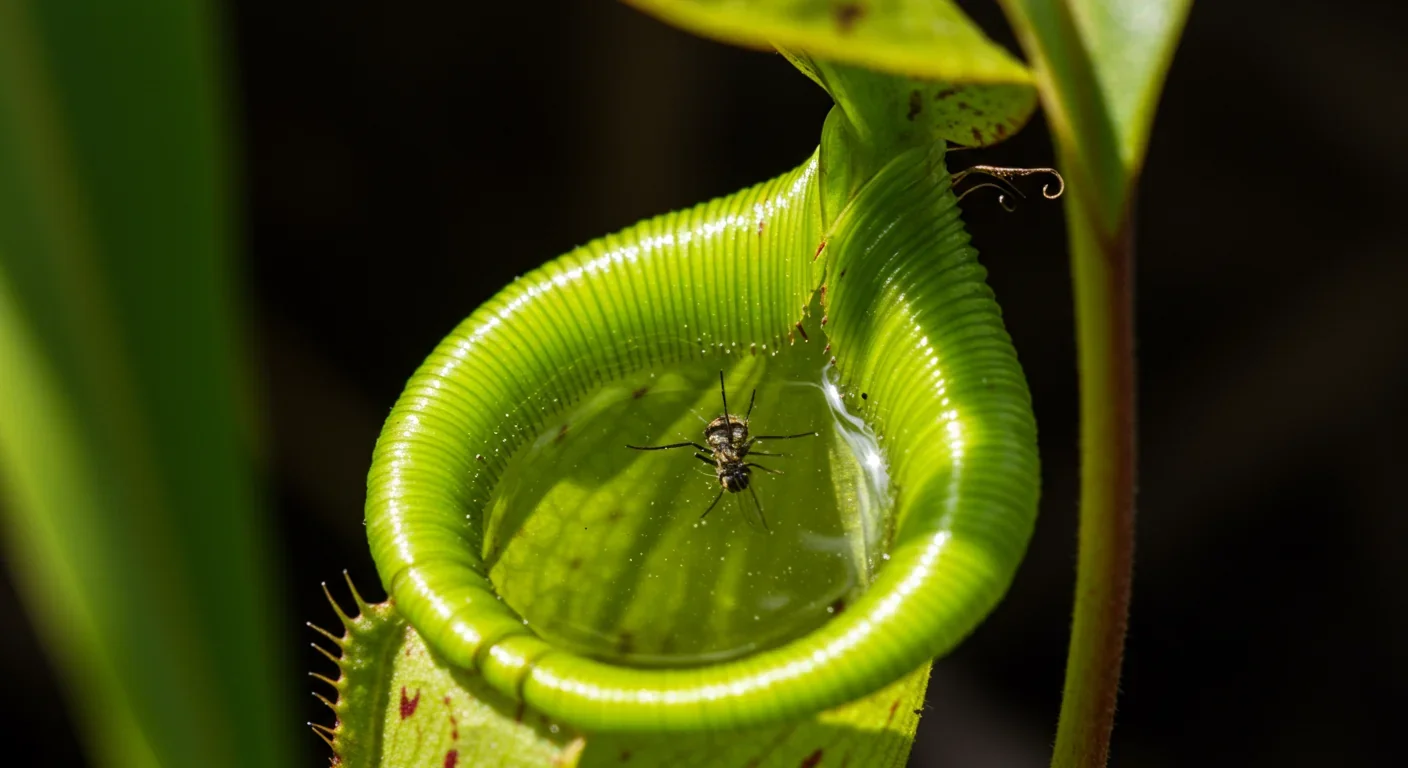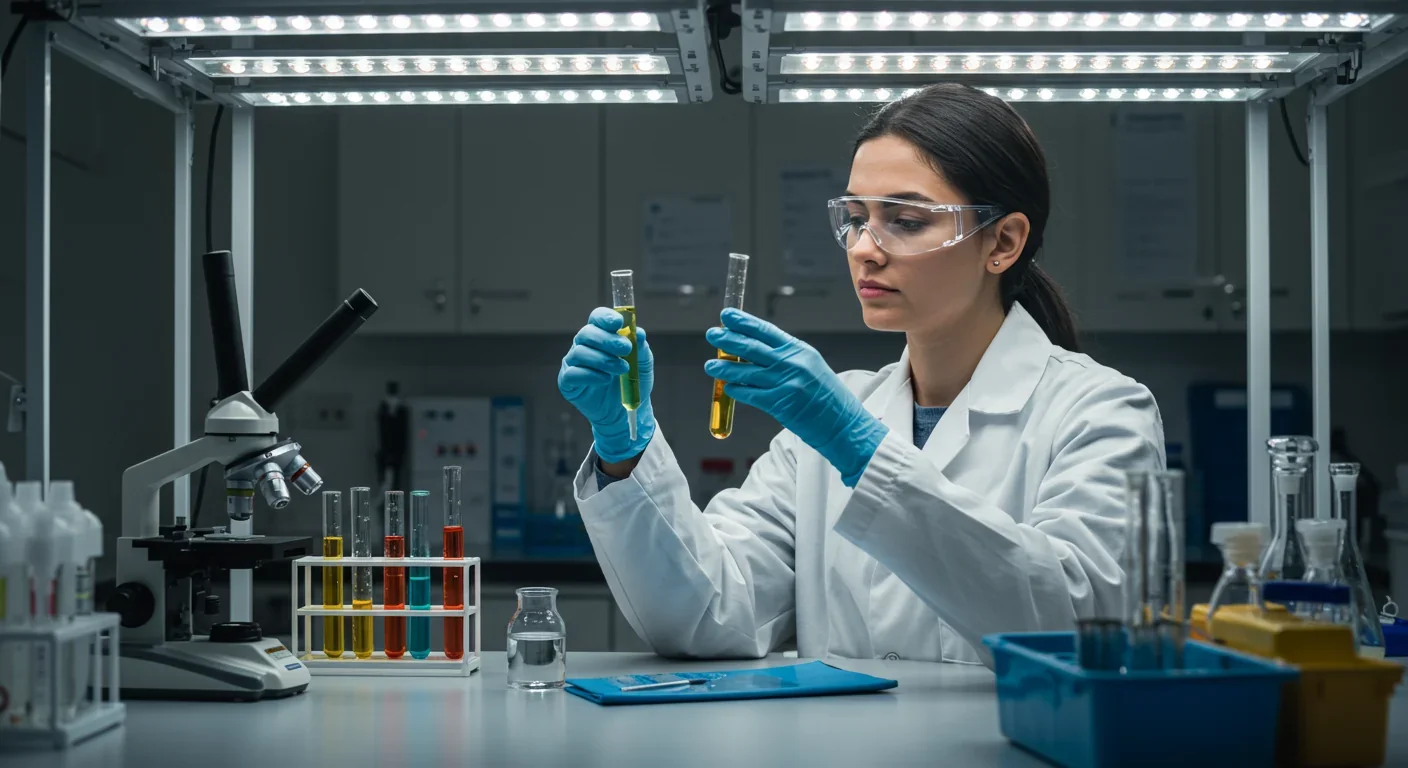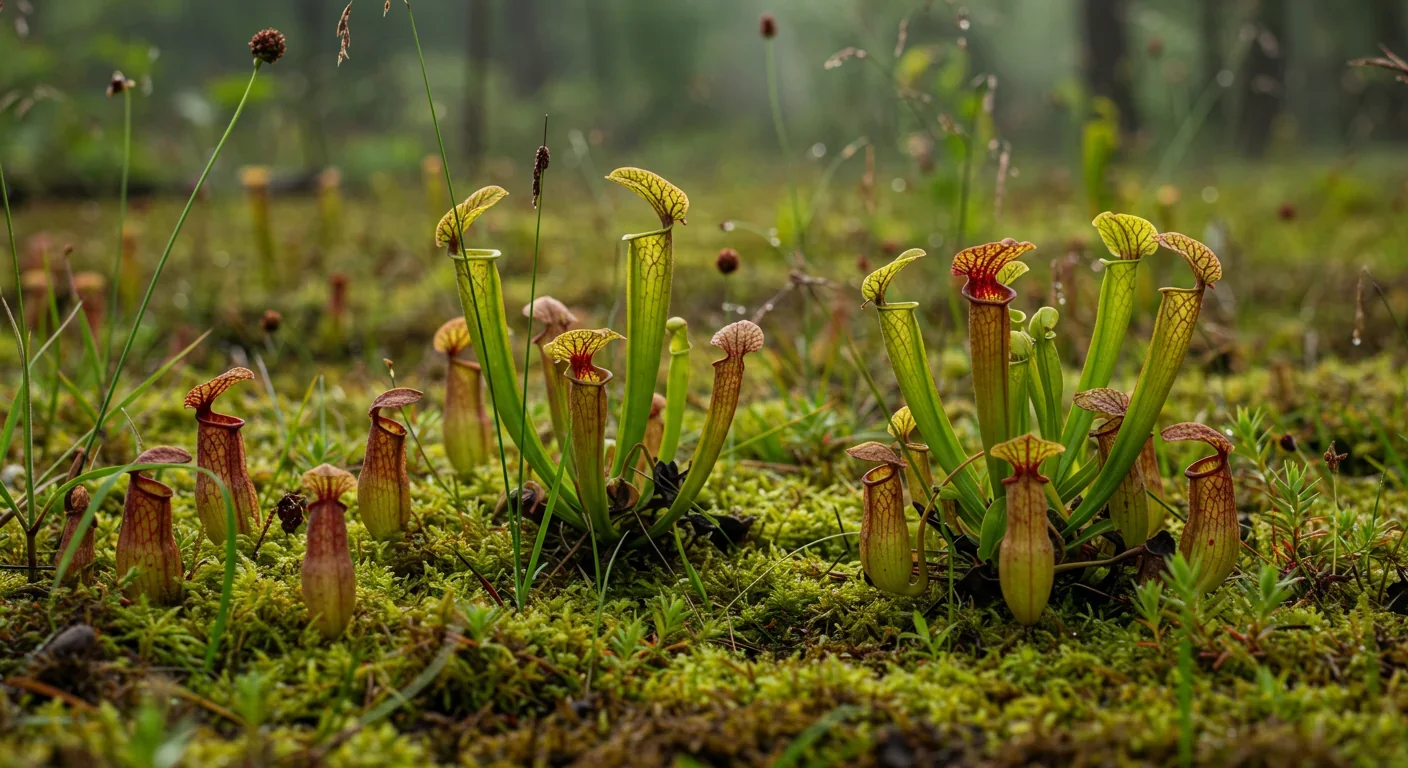Bombardier Beetle Chemical Defense: Nature's Micro Engine

TL;DR: Pitcher plants host sophisticated microbial ecosystems where bacteria, fungi, and protists work together to digest insect prey, providing nutrients the plant cannot extract alone. This ancient symbiosis, refined over 47 million years across multiple carnivorous plant lineages, demonstrates convergent evolution: plants on different continents independently cultivated similar microbial toolkits. Scientists are now decoding these micro-jungles to unlock biotechnological applications—from novel enzymes for industrial processes to insights for designing synthetic microbial communities for medicine, agriculture, and environmental remediation.

Inside every pitcher plant, a microscopic civilization thrives. Bacteria digest prey the plant cannot break down alone. Fungi decompose chitin from insect exoskeletons. Protists and rotiters shred tissue into absorbable nutrients. This isn't contamination—it's a finely tuned symbiosis millions of years in the making, and scientists are only now decoding how these invisible partners transformed plants into carnivores.
The implications stretch far beyond botany. What researchers are discovering in these thumb-sized traps could revolutionize everything from industrial enzyme production to understanding how complex ecosystems self-organize. Within the next decade, insights from pitcher plant microbiomes may yield novel antibiotics, biodegradable plastics, and even new approaches to treating human gut disorders. The tiny jungle inside these plants is teaching us that nature's most remarkable innovations often happen at scales we can barely see.
For over a century, botanists assumed pitcher plants were solo hunters—that the plants themselves secreted all the enzymes needed to dissolve insects into nutritious soup. That view collapsed in the early 2000s when researchers discovered that most Heliamphora species produce virtually no digestive enzymes at all. Instead, they rely entirely on bacterial communities to break down prey.
The revelation triggered a cascade of discoveries. By 2015, metatranscriptomic studies revealed that pitcher fluid harbors thousands of microbial genes coding for hydrolases, proteases, chitinases, and lipases—the complete enzymatic toolkit for dismantling insect bodies. A 2024 study sequencing 8.9 million full-length 16S rRNA reads from Sarracenia pitchers achieved 93% taxonomic classification accuracy, unveiling a structurally diverse microbiome organized into 3–7 distinct community clusters with 8 hub genera and 19 connector genera orchestrating the ecosystem.
What stunned researchers most was the functional convergence: pitcher plants separated by 47 million years of evolution—Sarracenia in North America, Nepenthes in Southeast Asia, Genlisea in South America—all cultivate remarkably similar microbial toolkits despite hosting taxonomically different bacteria. The selective pressure isn't for specific bacterial species; it's for specific metabolic functions. Evolution discovered the same solution independently, again and again: outsource digestion to microbes.
Carnivory in plants has evolved at least six independent times over the past 70 million years, always in nutrient-starved environments where nitrogen and phosphorus are desperately scarce. Pitcher plants represent one of evolution's most elegant solutions: transform a leaf into a passive trap, fill it with rainwater, and let chemistry do the rest.
But there's a metabolic cost to producing digestive enzymes. Proteases, chitinases, and nucleases require significant nitrogen to synthesize—the very nutrient carnivorous plants are trying to acquire. Early pitcher plants faced a Catch-22: spend precious nitrogen to make enzymes that might capture more nitrogen, or conserve resources and grow slowly.
Bacteria offered a third option. Microbes naturally colonize any standing water, and some produce extracellular enzymes to scavenge nutrients. Pitcher plants that evolved fluid chemistry favoring these digestive bacteria gained a competitive advantage: they got enzyme production for free while their microbial partners gained a stable habitat rich in insect-derived nutrients. Over millions of years, this facultative relationship became obligate. Today, Sarracenia and Darlingtonia rely on commensal bacteria to supplement or produce all of their digestive enzymes.
The evolutionary timeline is striking. The Sarraceniaceae family originated in South America about 47 million years ago and spread to North America around 35 million years ago. Sarracenia and Heliamphora diverged from Darlingtonia roughly 35–54 million years ago, and Sarracenia and Heliamphora split around 23–36 million years ago. Each lineage independently refined its microbial partnerships, converging on similar functional solutions despite divergent bacterial taxonomies.
History teaches us that major technological leaps often involve specialization and outsourcing. The Industrial Revolution succeeded because factories didn't make every component in-house; they relied on supply chains. Pitcher plants discovered this principle 30 million years before humans invented the assembly line.

When a pitcher opens, its fluid is sterile—a blank slate. Within days, bacteria, fungi, protists, and even tiny invertebrates colonize the trap. But this isn't random contamination; the plant actively shapes its microbiome through chemistry.
Pitcher fluid contains secondary metabolites and antimicrobial proteins—pathogenesis-related proteins, thaumatin-like proteins, proteases, and chitinases—that function as chemical bouncers. These compounds create a hostile environment for opportunistic pathogens while permitting digestive symbionts to thrive. At least 29 antimicrobial proteins patrol Nepenthes fluid, maintaining a selective barrier that recruits functional partners and repels freeloaders.
The fluid's pH is another selection mechanism. Sarracenia purpurea maintains a higher pH than most carnivorous pitchers, creating a more neutral environment that supports a diverse community including the mosquito Wyeomyia smithii and the midge Metriocnemus knabi. Other species maintain acidic conditions that favor acid-tolerant bacteria.
Once established, the microbial community operates like a stratified factory. Plant enzymes initiate breakdown, softening insect cuticles and releasing nutrients. Bacterial enzymes take over next, deploying proteases to cleave proteins into peptides, chitinases to degrade exoskeletons into oligosaccharides, lipases to break down fats, and DNases to fragment nucleic acids. Finally, protists such as ciliates and amoebae, along with rotifers like Habrotrocha rosa, physically shred tissue, accelerating mineralization and nutrient release.
This cascade mirrors industrial bioreactors, where enzymes work in sequence to progressively decompose complex substrates. The pitcher plant discovered continuous-flow biochemical processing millions of years before humans patented the concept.
Key bacterial genera appear consistently across pitcher plant microbiomes worldwide. Pseudomonas and Serratia are nearly universal. Serratia species are particularly versatile, secreting DNase, lipase, protease, gelatinase, chitinase, and alkaline phosphatase—a comprehensive enzymatic arsenal. Their multi-enzymatic capability positions them as central digestive agents, bridging plant and microbial metabolic pathways.
In Genlisea traps, which function as root-substitutes anchoring the plant in soil, the microbiome is even more specialized. Up to 38% of bacterial reads belong to Planctomycetes and Verrucomicrobia—phyla vastly overrepresented compared to typical root microbiomes. These traps also enrich for nitrifying (ammonia-oxidizing) and denitrifying (nitrite-reducing) bacteria, suggesting a coupled nitrification-denitrification cycle that complements direct enzymatic digestion. The plant doesn't just absorb amino acids and ammonium; it farms a nitrogen-cycling ecosystem.
Metatranscriptomic analysis of Genlisea traps identified 438 hydrolase-related transcripts—proteases, phosphatases, lipases—largely resembling those of metazoans, ciliates, and green algae. The trap functions as a microbial incubator, hosting SAR protists, algae, metazoans, and diverse bacterial taxa working in concert to mineralize prey.
Understanding pitcher plant microbiomes isn't just academic curiosity; it's a blueprint for biotechnological innovation. These micro-ecosystems have evolved solutions to problems that industrial biotechnology struggles with: stable enzyme production in fluctuating environments, efficient decomposition of recalcitrant materials, and self-assembling microbial consortia that perform complex metabolic tasks without external control.
Consider enzyme production. Industrial bioreactors typically rely on monocultures of genetically engineered bacteria grown in carefully controlled conditions. Pitcher plants maintain diverse microbial communities that produce a full suite of digestive enzymes autonomously, adapting to prey availability and environmental shifts. If we could replicate this self-regulating enzyme production, we could revolutionize industries from wastewater treatment to biofuel production.
Chitinases offer a concrete example. These enzymes break down chitin—the structural polymer in arthropod exoskeletons and fungal cell walls—into N-acetylglucosamine sugars. Chitin is the second most abundant biopolymer on Earth after cellulose, yet it's vastly underutilized. Pitcher plant bacteria have evolved highly efficient chitinases for digesting insect prey. Commercial applications already exist: chitinases are used in agriculture to control fungal pathogens, in contact lens manufacturing to prevent protein buildup, and in bioremediation to degrade chitinous waste. Pitcher plant-derived chitinases could improve these processes or enable new ones, such as converting shellfish waste into biodegradable plastics.
The biosurfactants produced by Serratia marcescens—commonly found in pitcher fluid—are used in agriculture and marine bioremediation as emulsifiers. These compounds help break down hydrophobic pollutants, suggesting that pitcher plant microbiomes could inspire novel bioremediation strategies for oil spills or industrial contamination.
Beyond enzymes, pitcher plant microbiomes offer insights into ecosystem engineering. These plants don't passively accept whatever microbes arrive; they actively curate their communities through chemistry, creating selective environments that recruit functional partners. This principle could inform synthetic ecology—designing microbial consortia for specific tasks such as soil remediation, crop protection, or even human gut health.
In medicine, the parallels are striking. The human gut microbiome, like pitcher fluid, harbors diverse microbial communities that perform essential metabolic functions the host cannot accomplish alone. Both systems exhibit functional redundancy—different bacterial species can perform the same metabolic roles—and both are shaped by host-derived selective pressures. Understanding how pitcher plants maintain stable, functional microbiomes despite environmental variability could inspire new probiotics or microbiome-based therapies.
Yet as with any technological leap inspired by nature, there are risks. Harvesting microbial strains from wild pitcher plants could threaten already vulnerable populations. Many pitcher plant species are endangered due to habitat loss and poaching by collectors. Large-scale bioprospecting could accelerate these declines unless carefully regulated.
Intellectual property questions loom. Who owns the genetic sequences of bacteria evolved within pitcher plants? Indigenous communities in Southeast Asia, where Nepenthes species are native, have traditional knowledge of these plants. If biotechnology companies patent enzymes derived from pitcher plant microbiomes, do those communities deserve compensation? The history of biopiracy—extracting natural resources from developing nations without fair compensation—casts a long shadow.
There's also the risk of ecological disruption. Introducing pitcher plant bacteria into new environments for bioremediation or agriculture could have unforeseen consequences. Serratia species, while useful, can be opportunistic pathogens in immunocompromised individuals. Releasing engineered strains into the wild without rigorous safety testing could create public health hazards or disrupt native microbial communities.
Moreover, the reductionist impulse to extract and commodify individual bacterial strains risks missing the forest for the trees. Pitcher plant microbiomes function as integrated systems, not collections of isolated species. A chitinase gene patented and expressed in E. coli in a lab might not perform as efficiently as the same gene operating within its native microbial consortium, surrounded by complementary enzymes and metabolic partners. We may find that the true innovation isn't any single microbe, but the emergent properties of the community as a whole—properties difficult to replicate in industrial settings.
Finally, there's the ethical dimension of synthetic biology. If we learn to engineer self-assembling microbial ecosystems inspired by pitcher plants, what are the boundaries? Should we design microbial consortia to colonize human bodies for medical purposes? To terraform barren landscapes? To process industrial waste? Each application brings benefits but also raises questions about unintended consequences and long-term ecological impacts.

Different cultures and scientific communities approach pitcher plant research with distinct priorities and philosophies. In Southeast Asia, where Nepenthes species are most diverse, conservation often takes precedence. Malaysian and Indonesian researchers emphasize protecting pitcher plant habitats and documenting traditional knowledge before it's lost. For these communities, pitcher plants aren't just biological curiosities; they're cultural heritage and potential economic resources.
In contrast, North American researchers—working primarily with Sarracenia species—tend to focus on fundamental ecology and evolutionary biology. The emphasis is on understanding microbiome assembly, host-microbe interactions, and evolutionary convergence. Leonora Bittleston's work at Boise State University exemplifies this approach. Her laboratory uses controlled tubes and programmable growth chambers to replicate pitcher plant fluid, feeding ground cricket powder to microbial communities and tracking their composition with precision. The $810,000 Simons Early Career Investigator Award she received in 2023 underscores the value placed on this model-system approach: using pitcher plants as tractable systems to answer broader questions about microbial ecology.
European researchers, particularly in Germany and the UK, have pioneered metatranscriptomic approaches to study gene expression in pitcher microbiomes. These studies reveal not just which microbes are present but what they're actively doing—which enzymes they're producing, which metabolic pathways they're activating. This focus on function over taxonomy aligns with Europe's leadership in systems biology and biotechnology.
In South America, where Genlisea and Heliamphora species are native, research often intersects with conservation and climate change. These plants inhabit fragile tepui ecosystems—ancient, isolated mountaintop habitats that are climate refugia but also highly vulnerable to warming temperatures. Understanding how their microbiomes function under stress could inform conservation strategies and predict how these ecosystems will respond to environmental change.
International collaboration is accelerating. Comparative studies across continents reveal convergent evolution in microbiome function despite divergent taxonomies, suggesting universal principles govern microbial community assembly. Yet competition persists. The race to patent novel enzymes, biosurfactants, and biotechnological applications incentivizes secrecy and can hinder open science.
The challenge moving forward is balancing these interests—conservation, traditional knowledge, fundamental research, and commercial innovation—in ways that distribute benefits equitably and protect vulnerable ecosystems.
As microbial ecology matures from descriptive science to predictive engineering, pitcher plants offer both a model and a cautionary tale. They demonstrate that invisible partnerships can radically expand an organism's capabilities, but also that those partnerships are products of millions of years of co-evolution, not easily replicated or controlled.
For students and professionals entering this field, the skills in demand are shifting. Computational biology—analyzing massive sequencing datasets—is as essential as traditional microbiology. Understanding ecology, evolution, and systems thinking matters as much as molecular techniques. The future belongs to those who can bridge disciplines, integrating chemistry, microbiology, plant physiology, and bioinformatics to understand complex systems holistically.
For society at large, preparing means grappling with the ethical and regulatory frameworks for synthetic ecology. As we learn to design microbial communities for specific functions, we'll need policies governing their release, monitoring their impacts, and ensuring equitable access to their benefits. We'll need public engagement so that decisions about these technologies aren't made solely by scientists and corporations but reflect broader societal values.
We'll also need humility. Pitcher plants remind us that nature has been running biotech experiments for millions of years, and the solutions evolved in tiny traps may be more elegant, efficient, and resilient than anything we can engineer. The goal isn't to dominate or replace natural systems but to learn from them, respecting the complexity and wisdom embedded in ecosystems we're only beginning to understand.
The microbes in a pitcher plant are invisible to the naked eye, but they sustain a carnivorous lifestyle that would be impossible otherwise. As we face global challenges—feeding billions, cleaning polluted environments, treating diseases—we may find that our best allies, like those of the pitcher plant, are partners too small to see but too important to ignore. The tiny jungle inside every trap is a reminder that the future isn't always built by giants; sometimes, it's shaped by the smallest players working together in ways we're only now learning to decode.
The next time you see a pitcher plant, remember: you're looking at a micro-civilization, a natural biotechnology lab, and a blueprint for innovation that could reshape industries. The revolution is already growing—quietly, invisibly, one microscopic partnership at a time.

Recent breakthroughs in fusion technology—including 351,000-gauss magnetic fields, AI-driven plasma diagnostics, and net energy gain at the National Ignition Facility—are transforming fusion propulsion from science fiction to engineering frontier. Scientists now have a realistic pathway to accelerate spacecraft to 10% of light speed, enabling a 43-year journey to Alpha Centauri. While challenges remain in miniaturization, neutron management, and sustained operation, the physics barriers have ...

Epigenetic clocks measure DNA methylation patterns to calculate biological age, which predicts disease risk up to 30 years before symptoms appear. Landmark studies show that accelerated epigenetic aging forecasts cardiovascular disease, diabetes, and neurodegeneration with remarkable accuracy. Lifestyle interventions—Mediterranean diet, structured exercise, quality sleep, stress management—can measurably reverse biological aging, reducing epigenetic age by 1-2 years within months. Commercial ...

Data centers consumed 415 terawatt-hours of electricity in 2024 and will nearly double that by 2030, driven by AI's insatiable energy appetite. Despite tech giants' renewable pledges, actual emissions are up to 662% higher than reported due to accounting loopholes. A digital pollution tax—similar to Europe's carbon border tariff—could finally force the industry to invest in efficiency technologies like liquid cooling, waste heat recovery, and time-matched renewable power, transforming volunta...

Humans are hardwired to see invisible agents—gods, ghosts, conspiracies—thanks to the Hyperactive Agency Detection Device (HADD), an evolutionary survival mechanism that favored false alarms over fatal misses. This cognitive bias, rooted in brain regions like the temporoparietal junction and medial prefrontal cortex, generates religious beliefs, animistic worldviews, and conspiracy theories across all cultures. Understanding HADD doesn't eliminate belief, but it helps us recognize when our pa...

The bombardier beetle has perfected a chemical defense system that human engineers are still trying to replicate: a two-chamber micro-combustion engine that mixes hydroquinone and hydrogen peroxide to create explosive 100°C sprays at up to 500 pulses per second, aimed with 270-degree precision. This tiny insect's biochemical marvel is inspiring revolutionary technologies in aerospace propulsion, pharmaceutical delivery, and fire suppression. By 2030, beetle-inspired systems could position sat...

The U.S. faces a catastrophic care worker shortage driven by poverty-level wages, overwhelming burnout, and systemic undervaluation. With 99% of nursing homes hiring and 9.7 million openings projected by 2034, the crisis threatens patient safety, family stability, and economic productivity. Evidence-based solutions—wage reforms, streamlined training, technology integration, and policy enforcement—exist and work, but require sustained political will and cultural recognition that caregiving is ...

Every major AI model was trained on copyrighted text scraped without permission, triggering billion-dollar lawsuits and forcing a reckoning between innovation and creator rights. The future depends on finding balance between transformative AI development and fair compensation for the people whose work fuels it.